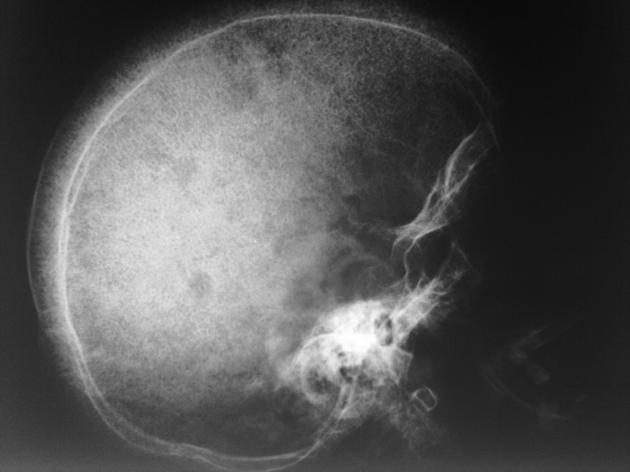WBR0150
| Author | PageAuthor::William J Gibson |
|---|---|
| Exam Type | ExamType::USMLE Step 1 |
| Main Category | MainCategory::Genetics |
| Sub Category | SubCategory::Hematology, SubCategory::Musculoskeletal/Rheumatology |
| Prompt | [[Prompt::A 7-year-old male presents to his pediatrician with fatigue and pallor. The patient recently emigrated from Greece and his parents report that he has a long history of “sickliness”. When he became very ill in the past he was taken to the hospital and given a blood transfusion. Complete blood count shows a hemoglobin of 5.7 g/dL, white blood cell count of 12.7x109 /L. platelet count of 250 x 109 /L, and mean corpuscular volume of 70. The child is unusually small and has a pronounced forehead. A radiograph of the skull is shown below. What is the most likely type of mutation that is responsible for this patient’s disease?
 |
| Answer A | AnswerA::Splice site mutation |
| Answer A Explanation | AnswerAExp::Beta thalassemia is most often caused by splice site mutations in the beta globin gene. |
| Answer B | AnswerB::Nonsense mutation |
| Answer B Explanation | [[AnswerBExp::Beta thalassemia is most often caused by splice site mutations in the beta globin gene. Nonsense mutations introduce a premature stop codon in the gene. An example of a disorder caused by germline nonsense mutations is Duchenne Muscular Dystrophy.]] |
| Answer C | AnswerC::Missense mutation |
| Answer C Explanation | AnswerCExp::Beta thalassemia is most often caused by splice site mutations in the beta globin gene. An example of a disorder caused by germline nonsense mutations is Becker Muscular Dystrophy. |
| Answer D | AnswerD::Gene deletion |
| Answer D Explanation | AnswerDExp::Beta thalassemia is most often caused by splice site mutations in the beta globin gene. An example of a disorder caused by deletions is Duchenne Muscular Dystrophy. |
| Answer E | AnswerE::Gene silencing |
| Answer E Explanation | AnswerEExp::Beta thalassemia is most often caused by splice site mutations in the beta globin gene. Gene silencing is most often achieved by methylation of the gene promoter. An example of a disorder caused by gene silencing is Prader-Wili syndrome. |
| Right Answer | RightAnswer::A |
| Explanation | [[Explanation::The patient in this vignette is suffering from beta-thalassemia major. Beta thalassemia is most often caused by splice site mutations in the beta-globin gene and is prevalent in Mediterranean populations. If both alleles of the beta globin gene have thalassemia mutations, beta thalassemia major is diagnosed. This is a severe microcytic, hypochromic anemia. Untreated, it causes anemia, splenomegaly, and severe bone deformities. It often progresses to death before age 20. A hallmark feature of beta thalassemia major is the “buzz cut” or “hair on end” appearance of the skull on X-ray. This increased spiky opacity is caused by bone marrow expansion in response to chronic anemia. (extramedullary hematopoeisis). Treatment consists of periodic blood transfusion; splenectomy if splenomegaly is present, and treatment of transfusion-induced iron overload with chelation therapy. Cure is possible only by bone marrow transplantation. Educational Objective: Beta Thalassemia is caused by splice site mutations in the beta-globin gene. |
| Approved | Approved::Yes |
| Keyword | WBRKeyword::Blood, WBRKeyword::Hematology, WBRKeyword::Genetics, WBRKeyword::Thalassemia, WBRKeyword::Beta thalassemia, WBRKeyword::Transfusion, WBRKeyword::Iron, WBRKeyword::Mutation |
| Linked Question | Linked:: |
| Order in Linked Questions | LinkedOrder:: |